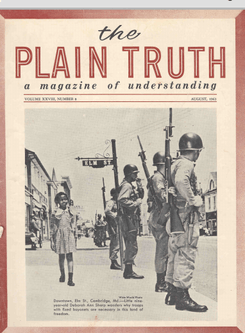The Plain Truth
 The Plain Truth (August 1969) | |
| Categories | Religious and general magazine |
|---|---|
| Frequency | Monthly |
| Total circulation | 8m (at its peak) |
| First issue | February 1934 |
| Company | The Worldwide Church of God |
| Country | United States |
| Language | English (also published many language issues) |

The Plain Truth, a former free of charge monthly magazine, was first published in 1934 by Herbert W. Armstrong, founder of The Radio Church of God, which he later named The Worldwide Church of God (WCG). The magazine subtitled as The Plain Truth: a magazine of understanding gradually developed into an international, free of charge news magazine, sponsored by the WCG church membership. The magazine's messages often centered on the controversial doctrine of British Israelism, the belief that the early inhabitants of the British Isles, and hence their descendants, were actually descendants of the Ten Lost Tribes of Israel.
By 1986, The Plain Truth was published in seven languages. The magazine's monthly circulation was roughly 8.2 million; in contrast, Time magazine's 1986 monthly circulation was 5.9 million.
After Armstrong's death in 1986, new WCG leadership sought to change the core principles of WCG Church doctrine, quashed publication of Armstrong's writings, sold off most of the church's holdings and began offering magazine subscriptions for sale. WCG leadership eventually changed the name of the organization and embraced positions closer to those of mainstream Protestantism.
After Joseph W. Tkach took over with major doctrinal transformation of the Worldwide Church of God, the circulation of The Plain Truth, distributed free by subscription and via newsstand distribution around the globe, fell from a peak of 8,000,000 to less than 100,000 before it switched to a paid subscription status. Eventually the magazine was spun off into a separate, independent, evangelical ministry as Plain Truth Ministries.[1]
The Plain Truth magazine as founded by H. W. Armstrong is no longer in print. However, two organizations, legally unrelated to each other or the original group, currently publish a magazine under the same name, one in the United Kingdom and one in the United States.